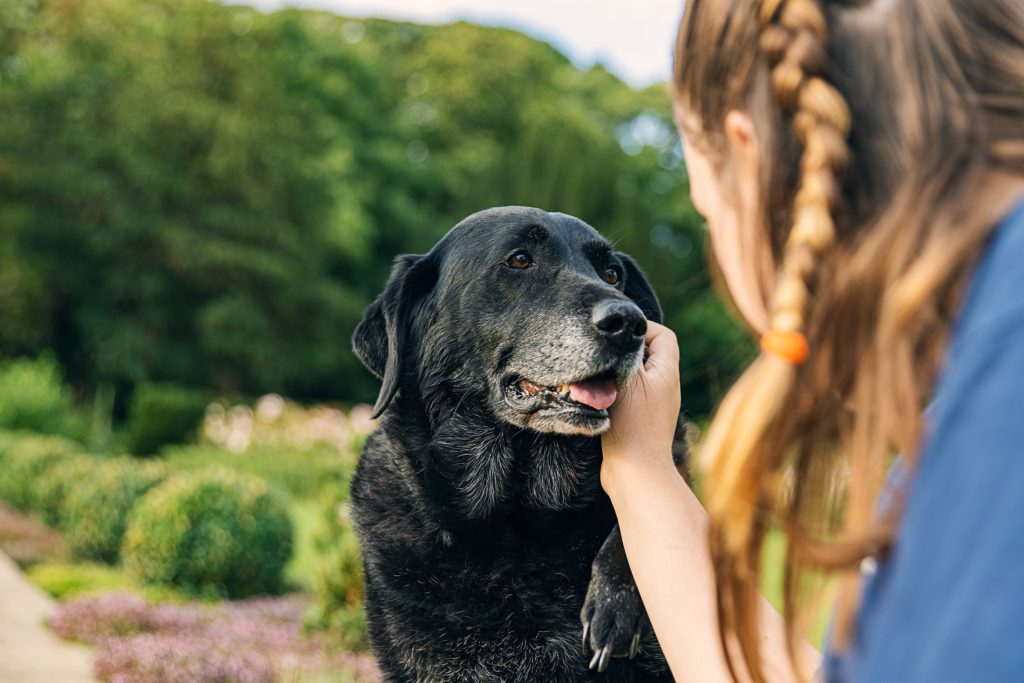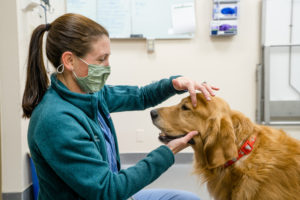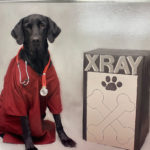
Exploring canine cognitive dysfunction.
The doctor just looked at me. If there was bad news coming, I said, just tell me. What’s the problem? My head went to all kinds of bad places while he hesitated, before quietly murmuring, “It’s probably just a sign of… aging.”
That wasn’t particularly helpful nor was it comforting. The finality of it left me to wonder if he’d just thrown up his hands, with no explanation or treatment suggestions; kind of an “oh well….”
It’s not an answer for your senior Lab’s new “quirks” either. Dr. Stephanie McGrath, an associate professor in neurology in the Clinical Sciences Department at Colorado State University, says the science has come far enough now that we don’t have to just live with “it.” Veterinary researchers may not have found a cure for canine cognitive dysfunction (CCD), but that doesn’t mean they can’t help your pup.
“We’ve been very apt to chalk it up to old age – ‘Well, he’s getting old, he has accidents in the house now, and he’s not really as aware,’” she says of some of CCD’s warning signs (see sidebar). “Instead of just assuming that it’s nothing or it’s the normal aging process, it’s something we should be much more aware of and much more proactive about than we were in the past.”
Dr. McGrath is one of many researchers tapping into the treasure trove of information being provided by the Dog Aging Project, an ambitious longitudinal study of tens of thousands of dogs (currently more than 32,000). A Precision Cohort of about 1,500 older dogs has also been recruited within the “pack” to provide in-depth laboratory analysis of DNA, blood, urine, fecal, and hair samples. Researchers will look at the biology of the dogs and how it may relate to cognitive changes being reported by owners. Still another study will dive into the genetics of CCD. After flagging 200 dogs that have CCD, they’ll identify the biomarkers for the disease and, ultimately in 100 of the dogs, identify neuropathological markers in the brain after they pass away.
While the research may lead to new treatments for CCD symptoms, Dr. McGrath is most interested in the disease itself – what causes it and how it may be prevented.
“To me, the ultimate goal in treatment, or even a cure, is to target the underlying process, rather than just treat symptomatically and put a Band-Aid over things,” she said. “It’s a progressive disease, and eventually these symptomatic treatments don’t continue to work. [Symptomatic treatment] may prolong the course of the disease or slow the course of the disease, but we’re not fixing it.
 “Ideally, if we could just prevent this disease from happening in a large portion of our population, whether it’s dog or human, that would be amazing. If we can’t prevent it, is there a drug out there that would help stop some of the pathways from degenerating; and as a follow-up to that, can we help reverse some of the signs that have occurred on a molecular level in the brain?”
“Ideally, if we could just prevent this disease from happening in a large portion of our population, whether it’s dog or human, that would be amazing. If we can’t prevent it, is there a drug out there that would help stop some of the pathways from degenerating; and as a follow-up to that, can we help reverse some of the signs that have occurred on a molecular level in the brain?”
Dr. McGrath admits the going has been slow. She says the scientific community hasn’t “come nearly as far as it probably should have,” especially with the dog being such a great model for the human disease counterpart – Alzheimer’s disease.
“We have done a little bit more work in the last decade looking at what’s happening in the brain, and it’s amazing how similar it is to the human disease,” she said of the canine research. In dogs with CCD, they’ve seen the amyloid plaques (abnormal clusters of protein fragments), vascular changes, neurons dying, and, most recently, they think they have identified neurofibrillary tangles (a breakdown of pathways in the brain that prevent nutrients from getting to brain cells), something they hadn’t thought occurred in dogs.
“Pathologically, we’ve made some advances, but we have a long way to go,” she said.
As usual, the studies have produced as many questions as answers: What is happening? Why is this happening? What risk factors exist? Is it all genetics, or are there external risk factors that may be predisposing some dogs to developing some signs of dementia? And because our dogs live with us – and live like us – work done in the veterinary laboratory will undoubtedly help owners, as well.
“It a very translational disease, meaning that the course of the disease (CCD) is very similar to the course of human dementia and Alzheimer’s,” Dr. McGrath said. And like humans, not all dogs are affected, leading to even more questions. “Why do some people age and never have cognitive disabilities, and why do others have either early onset dementia or eventually develop Alzheimer’s disease?”
Sadly, admits Dr. McGrath, research in the area of treatment – preventing or reversing the disease –hasn’t generated many answers, either. She’s hoping that work with the dog model will yield better results.
Most of the research has been done in rodents, including essentially all of the Food and Drug Administration trials for treatments. “And most of it failed because it is not a direct translational model; it’s not a good model for humans,” said McGrath, adding that while there is certainly a lot of value in the rodent model on a molecular level, it’s our canine companions that allow scientists to study external risk factors.
“Dogs have this unique ability in that they naturally develop this disease, and the course of the disease is remarkably similar to the course of dementias and Alzheimer’s in humans, so being able to study treatments in a large animal model like a dog is vastly superior [to mice],” she said. “We were missing that in-between step that we now have available. So we can help the dog – as a veterinarian that’s my goal – and use them as a surrogate in human testing. That’s a very unique change that’s been developed in the last decade. I think that’s super exciting.”
But what about treatments, even if they are just Band-Aids, to help our pups now? Studies have estimated that upwards of 35 percent of dogs age eight and older will develop some type of canine cognitive dysfunction. It’s hard to watch your senior pup struggle.
 Currently, says Dr. McGrath, veterinarians can target the symptoms – if our dog isn’t sleeping well at night, we can give them sleep aids to help them; if they are feeling anxious, we can give them a medication that can help with anxiety. She adds there are some approved and experimental drugs on the market. Selegiline, for example has been approved for dogs with CCD, and pet food maker Purina has done some research into nutritional strategies to create a kibble that may help limit the behavioral effects of CCD.
Currently, says Dr. McGrath, veterinarians can target the symptoms – if our dog isn’t sleeping well at night, we can give them sleep aids to help them; if they are feeling anxious, we can give them a medication that can help with anxiety. She adds there are some approved and experimental drugs on the market. Selegiline, for example has been approved for dogs with CCD, and pet food maker Purina has done some research into nutritional strategies to create a kibble that may help limit the behavioral effects of CCD.
Although the options may still be slim when it comes to prevention of the disease or its reversal, Dr. McGrath encourages owners to be proactive when it comes to symptom relief – and see your veterinarian when you first think “something’s up.”
“There are usually multiple signs; so if your dog develops one sign and it’s mild, it might not be significant, but if the owners are seeing that their dog has a few of these different signs, it would be a good idea to go for an initial assessment,” she said. “You want to make sure there’s nothing else going on. These are older dogs, and they could have a number of other things happening. If a dog is restless, maybe less interested in being petted, he could also have arthritis and chronic pain that makes him not feel as good. He may not want to go on walks as much, be a little bit more restless and uncomfortable, and not able to get in a good position to go to sleep.”
And don’t we all just want to be comfortable? That, after all, is another a sign of…aging.
CCD Warning Signs

Dr. Stephanie McGrath works with a canine patient during a clinical trial at the James L. Voss Veterinary Teaching Hospital. (Photo courtesy of photo credit of Colorado State University)
If you’re concerned that something is “not quite right” and your senior Lab may be slipping a bit, here are some things Dr. Stephanie McGrath, associate professor in neurology in the Clinical Sciences Department at Colorado State University, would have you look for. Keep in mind, however, that taken individually, they can all be vague and point to many other ailments.
“That is why we say always see your veterinarian first. You want to make sure there’s nothing else,” said Dr. McGrath, adding that, at the very least, you’ll have a baseline assessment to return to as your dog ages.
Disorientation or confusion is one of the more common clinical signs. Your dog may stare off into space a little more than normal or just seem to be “not quite there.” He may not recognize familiar people, pets, or objects.
Inability to navigate around familiar objects. Your dog goes to the same door each time he goes outside, but is now having a hard time going to the correct side of the door as it opens or is getting stuck under a piece of furniture and is unable to navigate his way out.
Changes in social relationships. Your pup may seem a little less interested in being petted or exhibit decreased greeting behavior. He will usually get excited when someone comes to the door, but is now a little bit more standoffish and not quite as excited as normal. He may also be a little more irritable.
Changes in the sleep-wake cycle. Your dog is sleeping more during the day and is restless at night, with pacing and vocalizations.
A change in house training. Your older dog may have been perfectly housetrained, but you’ve started to notice more accidents. You may have taken him for a walk where he didn’t do much, but then back home, he’ll have an accident in the house.
Pacing, wandering, anxiety, and fear. These signs are pretty common for dogs with canine cognitive dysfunction, especially anxiety. He can be more vocal and agitated; he may also be a little more fearful of auditory or visual stimuli. Maybe he was never nervous about thunderstorms but is now more anxious. (Dr. McGrath adds if the dog never liked thunderstorms, it wouldn’t be an issue.) A change in surfaces would also be in this category (if, for example, your dog is suddenly scared of walking on a bare floor instead of a carpet). For this symptom, it’s all about your dog not quite being sure about things he never used to be nervous about.
Separation anxiety. It can be a sign of CCD for dogs that develop separation anxiety later in life.
Learning and memory changes. You senior Lab may know hundreds of commands, but you’ve noticed a decrease in responsiveness to even the familiar commands; there are things he’s always known how to do, but he doesn’t seem to remember quite as well. And you’ve noticed difficulty in learning new tasks; if you’re trying to teach him something new, that would be a lot more challenging than it would have been five years ago.



